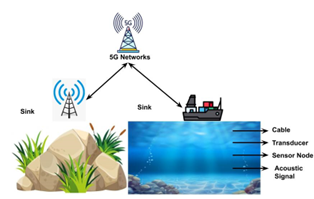Underwater Aerial Vehicle Networks Based Image Analysis By Deep Learning Architecture Integrated With 5G System
Main Article Content
Abstract
With its astonishing ability to learn representation from data, deep neural networks (DNNs) have made efficient advances in the processing of pictures, time series, spoken language, audio, video, and many other types of data.In an effort to compile the volume of information generated in remote sensing field's subfields, surveys and literature revisions explicitly concerning DNNs methods applications are carried out Aerial sensing research has recently been dominated by applications based on Unmanned Aerial Vehicles (UAVs).There hasn't yet been a literature review that integrates the "deep learning" and "UAV remote sensing" thematics.This research propose novel technique in underwater aerial vehicle networks based image analysis by feature extraction and classification utilizing DL methods. here UAV based images through on 5G module is collected and this image has been processed for noise removal, smoothening and normalization. The processed image features has been extracted using multilayer extreme learning based convolutional neural networks. Then extracted deep features has been classified utilizingrecursive elimination based radial basis function networks. The experimental analysis is carried out based on numerous UAV image dataset in terms of accuracy, precision, recall, F-measure, RMSE and MAP.Proposed method attained accuracy of 96%, precision of 94%, recall of 85%, F- measure of 72%, RMSE of 48%, MAP of 41%.
Article Details

This work is licensed under a Creative Commons Attribution-NoDerivatives 4.0 International License.
References
Cao, F., Yang, Z., Ren, J., Chen, W., Han, G., & Shen, Y. (2019). Local block multilayer sparse extreme learning machine for effective feature extraction and classification of hyperspectral images. IEEE Transactions on Geoscience and Remote Sensing, 57(8), 5580-5594.
Ding, S., Zhang, N., Xu, X., Guo, L., & Zhang, J. (2015). Deep extreme learning machine and its application in EEG classification. Mathematical Problems in Engineering, 2015.
Yang, A., Yang, X., Wu, W., Liu, H., & Zhuansun, Y. (2019). Research on feature extraction of tumor image based on convolutional neural network. IEEE access, 7, 24204-24213.
Chen, X. W., & Jeong, J. C. (2007, December). Enhanced recursive feature elimination. In Sixth International Conference on Machine Learning and Applications (ICMLA 2007) (pp. 429-435). IEEE.
Huang, W., & Wang, J. (2013). Design of polynomial fuzzy radial basis function neural networks based on nonsymmetric fuzzy clustering and parallel optimization. Mathematical Problems in Engineering, 2013.
Yang, Y., Wang, P., & Gao, X. (2022). A novel radial basis function neural network with high generalization performance for nonlinear process modelling. Processes, 10(1), 140.
Ramkumar, G., Ayyadurai, M., & Senthilkumar, C. (2021, May). An effectual underwater image enhancement using deep learning algorithm. In 2021 5th International Conference on Intelligent Computing and Control Systems (ICICCS) (pp. 1507-1511). IEEE.
Xu, S., Zhang, J., Qin, X., Xiao, Y., Qian, J., Bo, L., ... & Zhong, Z. (2022). Deep retinex decomposition network for underwater image enhancement. Computers and Electrical Engineering, 100, 107822.
Sarma, K., & Vigneshwaran, P. (2021, May). Underwater Image Enhancement Using Deep Learning. In International Conference on Image Processing and Capsule Networks (pp. 431-445). Springer, Cham.
Estrada, D. C., Dalgleish, F. R., Den Ouden, C. J., Ramos, B., Li, Y., & Ouyang, B. (2022). Underwater LiDAR image enhancement using a GAN based machine learning technique. IEEE Sensors Journal, 22(5), 4438-4451.
Zheng, Y., & Yang, Y. (2022). Underwater Image Processing and Target Detection Algorithm Based on Deep Learning. In International Conference on Multi-modal Information Analytics (pp. 368-374). Springer, Cham.
Maniyath, S. R., Vijayakumar, K., Singh, L., Sharma, S. K., & Olabiyisi, T. (2021). Learning-based approach to underwater image dehazing using CycleGAN. Arabian Journal of Geosciences, 14(18), 1-11.
Wang, N. (2022, April). Underwater color restoration and dehazing based on deep neural network. In Journal of Physics: Conference Series (Vol. 2234, No. 1, p. 012016). IOP Publishing.
Kharazi, B. A., & Behzadan, A. H. (2021). Flood depth mapping in street photos with image processing and deep neural networks. Computers, Environment and Urban Systems, 88, 101628.
Li, F., Lu, D., Lu, C., & Jiang, Q. (2022). Underwater Imaging Formation Model-Embedded Multiscale Deep Neural Network for Underwater Image Enhancement. Mathematical Problems in Engineering, 2022.
Politikos, D. V., Fakiris, E., Davvetas, A., Klampanos, I. A., & Papatheodorou, G. (2021). Automatic detection of seafloor marine litter using towed camera images and deep learning. Marine Pollution Bulletin, 164, 111974.

